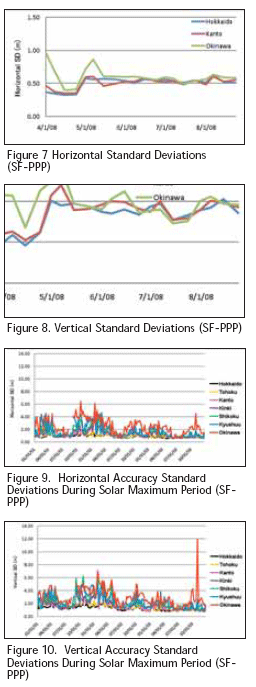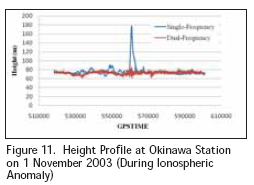| Mycoordinates | |
MSAS performance evaluation under ionospheric conditions
|
||||||||||||||||||||||||||||||
| User stations for evaluation
Seven stations were selected out of the GPS Earth Observation Network (GEONET) stations operated by the Japanese Geographical Survey Institute (GSI) from Hokkaido (Northern Japan) to Okinawa (Southern Japan) (http://www. gsi.go.jp/). These seven stations cover the whole domestic area of Japan. Figure 4 shows the locations of these seven stations. The name for each station represents the geographic region in Japan. The number in each parenthesis is the specifi c ID for each GEONET station. Raw data from each of these stations was collected every 30 seconds during the periods examined. MSAS and Single-Frequency PPP performance during solar-minimum period In this analysis, three stations were chosen from the set of seven shown in Figure 4: Hokkaido, Kanto, and Okinawa. Figure 5 shows the temporal variations of the standard deviations of MSAS horizontal accuracy for these three locations from 1th April 2008 to 24th August 2008. Figure 6 provides the same information for MSAS vertical accuracy. Figures 7 and 8 provide the same results for Single-Frequency PPP. The estimated (sample) standard deviations shown in these plots were calculated every week. The results were mostly as we expected. The horizontal and vertical standard deviations for MSAS were almost always below 1 meter, whereas SF-PPP vertical standard deviations were often near and sometimes above 1 meter. As can be seen the results in Okinawa, Okinawa station is affected by equatorial ionosphere even during solar minimum. While MSAS accuracy in these fi gures is somewhat better than that of Single-Frequency PPP, the difference is not large and is now fairly well understood. Therefore Single-Frequency PPP can be used to roughly estimate MSAS performance.
Single-Frequency PPP performance under solar maximum period Figure 9 shows the temporal variations of the standard deviations of horizontal accuracy from Single-Frequency PPP for all seven stations in Figure 4 from 1th January 2001 to 24th December 2003. Figure 10 provides the same information for the vertical accuracy of Single- Frequency PPP over this period. As can be seen from these results, positioning performance was clearly degraded during signifi cant fractions of this three-year period compared with the results during the recent solar-minimum period shown in Figures 7 and 8. As the latitude moves southward, positioning accuracy degrades because the southern part of Japan is closer to the equatorial region of the ionosphere and is more affected by the intense solar activity. When we examine seasonal changes, we found that the error decreased in summer, especially at the southern stations. This tendency partially coincides with the results given in [7]. Dual-Frequency based ionospheric error estimation As can be seen in Figure 9 and (particularly) Figure 10, very large errors can be seen around 1 November 2003 due to a very large solar coronal mass ejection (CME). This event created very large ionosphere errors several times during October and November 2003. Currently, it is impossible for single-frequency users to reduce ionospheric errors due to unusual events like this one. One solution is to use a dual-frequency receiver that can estimate and remove ionospheric delays in real time. We examined the positioning errors on this day using dual-frequency based ionospheric error estimation and compared these results to those derived from the IONEX fi le. Figure 11 compares the height (vertical) profi le at the Okinawa station on 1 November 2003 for these two methods (note that the actual height of the antenna at this station is about 71.5 m). Since only ionospheric error estimation differs between the two lines shown in Figure 11, it is clear that ionospheric error for standalone single-frequency users exceeded 100 meters at the peak of this event, but dual-frequency estimation dramatically reduced the effects of this anomaly. ConclusionMSAS and Single-Frequency PPP positioning were analyzed using raw -data covering the Japanese islands in 2008. The performance of these two systems was similar, although MSAS accuracy was somewhat better than that of Single- Frequency PPP. Single-Frequency PPP accuracy was analyzed during the more active solar conditions of 2001 to 2003, and its accuracy was signifi cantly degraded at times. Therefore, it is predicted that MSAS performance may also be degraded during future periods of high solar activity, although the degree of accuracy degradation depends on locations, season and time of date. The likely cause of this accuracy is mis-modeling of Vertical TEC by MSAS and GIM during very active solar conditions. Dual-frequency based ionospheric estimation can be used to remove most of these increased errors. AcknowledgmentsThe authors are very grateful to the Geographical Survey Institute, Japan (GSI) of Japan for providing the raw data used in this research. The authors also wish to thank Dr. Takeyasu Sakai of ENRI for providing post-processing software for MSAS analysis. The fi rst author gratefully acknowledges the Japan Ministry of Education, Culture, Sports, Sciences and Technology. References• Imamura J. (2003). “MSAS program and Overview, Proc.”, 4th CGSIC IISC Asia Pacifi c Rim Meeting, 2003 Joint International Conference on GPS /GNSS, Tokyo. • Sakai T, Matsunaga K and Hoshinoo K and Walter T. (2004). “Evaluating Ionospheric Effects on SBAS in the Low Magnetic Latitude Region”, 17th International Technical Meeting of the Satellite Division of Navigation (ION GNSS), 21-24 Sept.2004, Long Beach, CA, pp.1318-1328. • Le.AQ.(2004). “Achieving Decimeter Accuracy with Single Frequency Standalone GPS Positioning”,17th International Technical Meeting of the Satellite Division of Navigation (ION GNSS), 21-24 Sept.2004, Long Beach, CA, pp.1881-1892. • Misra, P. and Enge, P. (2006). “GLOBAL POSITIONING SYSTEM, Signals, Measurements, and Performance”, Chapter 5, Ganga-Jamuna Press. • Sakai T, Fukushima S, Aria N and Ito K (2006) ,Implementation of Prototype Satellite-Based Augmentation System (SBAS),International Global Navigation satellite System Society IGNSS Symposium 2006,17-21 July 2006,Australia. • MOPS (2001), Minimum Operational Performance Standards for Global Positioning System/Wide Area Augmentation System Airbone Equipment, DO-229C, RTCA, Nov. 2001. • Akio Yoshida, Takeshi Toya and Makiko Yoshida (2004). “Solar- Cycle and Semiannual Variations of Magnetic Storms”, Journal of Geography, 113(1), 2004, pp.107-124. |
||||||||||||||||||||||||||||||
|
||||||||||||||||||||||||||||||
|
Pages: 1 2

















 (No Ratings Yet)
(No Ratings Yet)




